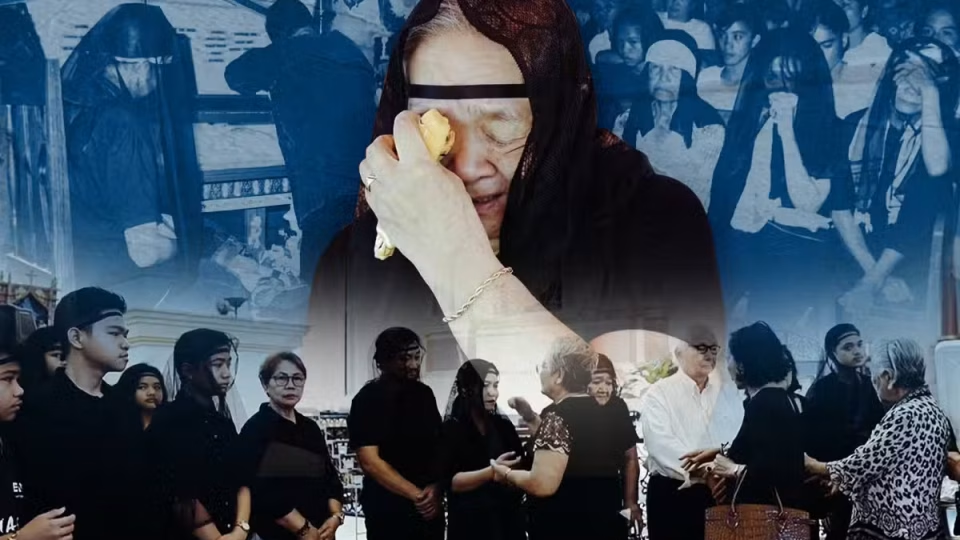October 31, 2025
MANILA – Who would not remember that one scene from the 1980s classic Himala, where people — all draped in black — walked in a somber procession for the burial of four individuals: Chayong and three more children.
It was more than a cinematic choice for visual impact as it was probably a deliberate invocation of meaning — an echo of how the color black is intertwined with Filipino expressions of grief.
The scene, indeed, captured more than a movie sequence as the color not only heightened the drama but also embodied severe sorrow, especially since in the Philippines, as in most of the world, black is the embodiment of sadness and loss.
While the color of bereavement varies across cultures and regions, like white in China or red in Ghana, black is the most common and widely recognized color for expressing grief, visually representing the emptiness left behind by someone who died.
But really, why black?
Sociologist Clifford Sorita said in an interview with INQUIRER.net that black is often associated with sorrow because of a combination of historical, cultural, and psychological factors.
He said that in ancient Rome, mourners wore dark togas to express sadness over someone’s death, while in Europe, the royals popularized the color for grief, such as Queen Victoria, who wore black for the rest of her life after the death of her husband.
Then in some cultures, black represents the opposite of the brightness of life, conveying darkness and a sense of restraint, bringing a mood that heightens the feeling of “void and loss.”
As stated in several memorial websites, “black has long been associated with solemnity, dignity and respect,” and that while it is not the universal color for grief, “it conveys depth of feeling, making it a natural choice for marking loss.”
For instance, in Paoay, Ilocos Norte, last year, members of a bereaved family wore black, as an expression of deep sorrow over a death — the passing of their patriarch, who was 75 years old.
Ilocano filmmaker Melver Gomez, one of the grandchildren of the deceased, shared to INQUIRER.net that the practice of panagmanto or the wearing of black veils while dressed entirely in black, varies across communities.
RELATED STORY: ‘Antoway’: Bontoc’s unique mourning for the dead at risk of dying
But those who do so, he said, drape themselves in black because (1) the deceased is old or (2) the death is sudden and that the pain inflicted by the loss is too heavy to grasp.
This was pointed out, as well, by Rogelio Mupas, who, together with his siblings, did the panagmanto in 1995, when their mother died of a heart disease at the age of 45, only two years after the death of her brother.
“We were told by our grandmother that we should be in black all throughout the wake and even after the funeral, saying that it is their practice in Cabatuan, Isabela, to have the bereaved wear black — from veils down to their shirts,” he told INQUIRER.net.
He stressed that “it expressly marked the deep and intense pain of losing a mother at a young age, especially since two of my younger siblings were only college students back then.”
Religious POV
Once colonized by the Spaniards, who brought Catholicism to the Philippines, it is no surprise that black has been associated with sorrow and death, even though some are now more into white.
This, as before the Second Vatican Council, black was “the color of sorrow, solemnity, and deep reflection,” said Fr. Prince Chidi Philip, stressing that “when the Church mourned, she wore black.”
“When the faithful gathered to pray for the dead, the priest, clothed in black, became a visible reminder that life is fragile and death is real,” he said, pointing out that in the church, the color once represented the “mystery of eternity.”
RELATED STORY: Remembering the dead: Understanding atang, why it endures
Even though the Second Vatican Council kept black as an “option,” it encouraged white or violet for Masses for the Dead in a bid “to emphasize hope, resurrection, and mercy, not fear.”
This, as he explained, that before the liturgical reforms, black was the only color for Requiem Masses as “funerals back then were not ‘celebrations of life’ but acts of intercession for souls.”
“The atmosphere was sober, sacred, and focused on the mystery of eternity. When the priest entered the church in black, incense filled the air, and everyone knew this was no social farewell. This was a spiritual battle for a soul,” he said.
Philip pointed out that “it’s not a color of despair, far from it. It’s a color of truth and realism, a liturgical whisper that says: Heaven is real, Purgatory is real, Hell is real, and our prayers for the dead matter.”
But as time changed, while black is still a choice, funerals are now often more personalized, with some asking people to wear white to “express hope for the resurrection” or the deceased’s favorite color.
As explained by Fr. Dennis Lauron to INQUIRER.net, “what is important is the deep devotion and strong desire of the bereaved to pray for the departed,” saying that the hundreds of Masses offered for the dead every single day “speaks a lot.”


